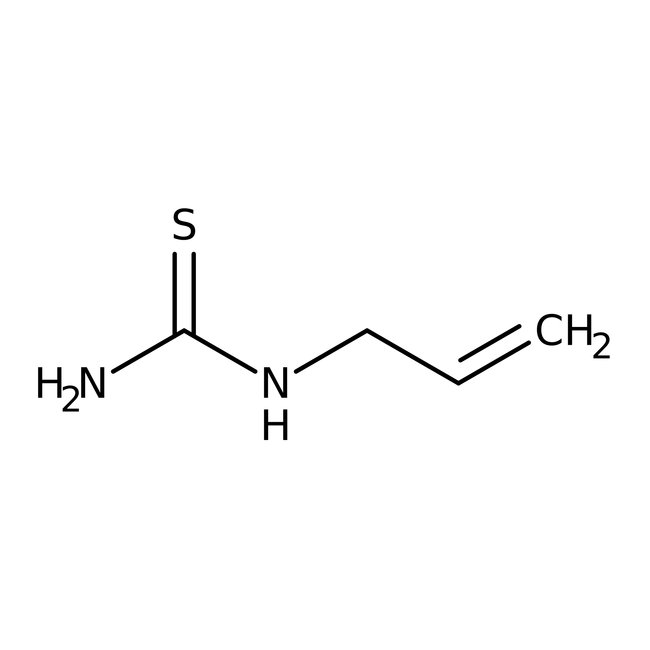Search Thermo Fisher Scientific
Thermo Scientific Chemicals
N-Allylthiourea, 98%
CAS: 109-57-9 | C4H8N2S | 116.182 g/mol
| Catalog Number | Quantity |
|---|---|
| ALFL03377.14 | 25 g |
Catalog number ALFL03377.14
View Price:Sign InSign in to see your account pricing. Need an account? Register with us today.
Quantity:
25 g
Specifications
Chemical Name or MaterialN-Allylthiourea
CAS109-57-9
Health Hazard 1H301
Health Hazard 2GHS H Statement
H301-H317
Toxic if swallowed.
May cause an allergic skin reaction.
H301-H317
Toxic if swallowed.
May cause an allergic skin reaction.
Health Hazard 3P264b-P270-P301+P310-P330-P501c
View more
N-Allylthiourea is a nitrification inhibitor used in the study on the transformation of diclofenac, naproxen and bisoprolol under aerobic and anaerobic conditions. It is also used in medicine to minimize scar tissue in order to fight against a type of dermatitis. Further, it inhibits the growth of transplanted tumors in mice. It acts as a chelating agent. In addition, it is used in cosmetics, preservative and in organic synthesis.
This Thermo Scientific Chemicals brand product was originally part of the Alfa Aesar product portfolio. Some documentation and label information may refer to the legacy brand. The original Alfa Aesar product / item code or SKU reference has not changed as a part of the brand transition to Thermo Scientific Chemicals.
Applications
N-Allylthiourea is a nitrification inhibitor used in the study on the transformation of diclofenac, naproxen and bisoprolol under aerobic and anaerobic conditions. It is also used in medicine to minimize scar tissue in order to fight against a type of dermatitis. Further, it inhibits the growth of transplanted tumors in mice. It acts as a chelating agent. In addition, it is used in cosmetics, preservative and in organic synthesis.
Solubility
Soluble in water and alcohol. Slightly soluble in diethyl ether. Insoluble in benzene.
Notes
Incompatible with strong oxidizing agents.
N-Allylthiourea is a nitrification inhibitor used in the study on the transformation of diclofenac, naproxen and bisoprolol under aerobic and anaerobic conditions. It is also used in medicine to minimize scar tissue in order to fight against a type of dermatitis. Further, it inhibits the growth of transplanted tumors in mice. It acts as a chelating agent. In addition, it is used in cosmetics, preservative and in organic synthesis.
Solubility
Soluble in water and alcohol. Slightly soluble in diethyl ether. Insoluble in benzene.
Notes
Incompatible with strong oxidizing agents.
RUO – Research Use Only
General References:
- Lee, W. S.; Chua, A. S. M.; Yeoh, H. K.; Nittami, T.; Ngoh, G. C. Strategy for the biotransformation of fermented palm oil mill effluent into biodegradable polyhydroxyalkanoates by activated sludge. Chem. Eng. J. 2015, 269, 288-297.
- Meriac, A.; Tilburg, T. P. A. V.; Eding, E. H.; Kamstra, A.; Schrama, J. W.; Verreth, J. A. J. Effects of diet composition and ultrasound treatment on particle size distribution and carbon bioavailability in feces of rainbow trout. Aquacult. Eng. 2015, 65, 10-16.



